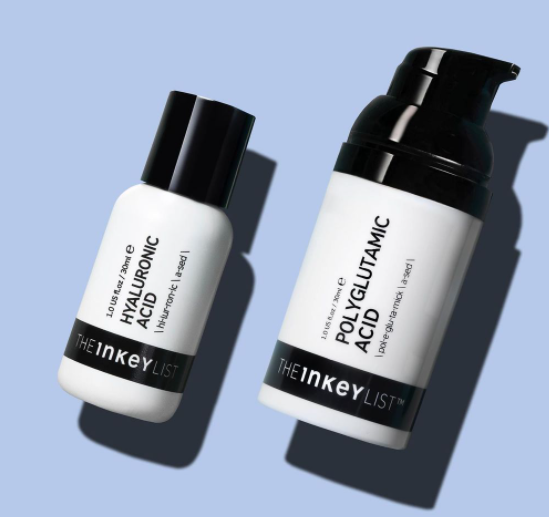 Credit : theinkeylist/Instagram
Credit : theinkeylist/InstagramContrary to what many skincare enthusiasts are saying, polyglutamic acid is not the new hyaluronic acid and will not replacing it anytime soon. Hyaluronic acid has long enjoyed the spotlight as the ultimate skin hydrator. It naturally occurs in the body and when applied topically, its small molecules penetrate deep into the skin to provide moisture at the lower levels. As a humectant, it draws water from the air and keeps skin moist. It holds 1000 times its weight in water and its skin care benefits are many. According to Byrdie hyaluronic acid moisturizes the skin, replenishes cell moisture, reduces the appearance of lines and wrinkles and speeds up wound healing.
On the other hand, newcomer polyglutamic acid isn't naturally occurring, but comes from natto or fermented soybeans and is produced in labs. Like hyaluronic acid, it is also a humectant, so it binds water to the skin. However, its molecules are bigger, so it doesn't penetrate as deeply but stays on the top layers.
Makeup artist and founder of Charlotte Tilbury Beauty, Charlotte Tilbury, is a big fan of polyglutamic acid and has developed a serum featuring the ingredient. As she shares with Byrdie, the loss of hyaluronic acid on the skin speeds up aging thanks to an enzyme called hyaluronidase that breaks it down. Polyglutamic acid helps inhibit hyaluronidase so that more hyaluronic acid is retained. This, she says, results to a plumper complexion and diminished pores.
Also read: What Do Occlusives in Skincare Products Do For Your Skin?
According to the Microbiology Society, polyglutamic acid can hold even more water than hyaluronic acid which also makes it a good ingredient for dehydrated skin. Since hyaluronic acid targets the lower layers of skin and polyglutamic acid provides surface hydration, using the two acids together will result in well-hydrated skin.
How to incorporate polyglutamic acid in your skincare routine?
As mentioned, polyglutamic acid works best with hyaluronic acid to boost hydration levels. According to Good Housekeeping, it also works well with niacinamide, retinol and vitamin C. Polyglutamic acid can be usually found in serums, moisturizers eye creams and sheet masks. Below are some recommendations that feature this new ingredient.
Inkey List Polyglutamic Acid
This lightweight face lotion is quick-absorbing and is ideal for dry and dehydrated skin. It's also very budget-friendly. As the colder temperatures of winter can cause skin to get dry, irritated, and flaky, now may be the best time to try it. The Inkey List Polyglutamic Acid is meant to be used after your toner and between your serum and moisturizer. For best results, apply a hyaluronic acid serum before your polyglutamic acid product. Allure recommends La Roche-Posay Hyalu B5 Pure Hyaluronic Acid Face Serum, First Aid Beauty Ultra Repair Hydrating Serum, or the cult favorite and pocket-friendly The Ordinary Hyaluronic Acid 2% + B5.
Charlotte Tilbury Magic Serum
Tilbury blends polyglutamic acid with powerful antioxidant vitamin C for smoother, plumper, and brighter skin.
Avant Satin-Soft Imperial Polyglutamic Acid DUO Moisturiser
A great option for dry winter skin, this moisturizer is also ideal for mature skin as it's designed to fade fine lines and wrinkles. it also has a matte finish so it can also serve as a makeup base.
Blanc & Eclare Serein Hydrating Mist
For an extra boost of moisture amidst the drier winter air, hydrate skin with this Blanc & Eclare mist that contains gylcerin, mineral-rich Tasmanian rainwater, polyglutamic acid and hyaluronic acid.
Related article: Dermatologists Teach You How to Repair and Protect Your Skin's Moisture Barrier

